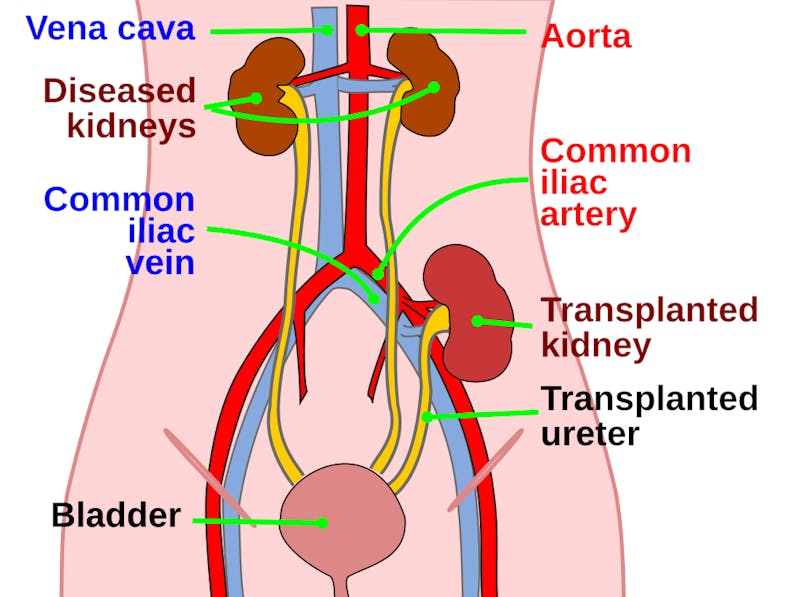Kidney Transplantation
Kidney transplantation or Renal transplantation is a process in which diseased kidney is replaced with a healthy kidney from a donor. It is considered the best treatment option for people facing kidney failure because it increases the chances of living a longer and healthier life. The patient can receive a kidney either from a nonliving (deceased) donor or from living related donors (family member, spouse or close friend). If family members are a good match, they may be able to donate one of their kidneys. Before surgery, the donor and the recipient are closely monitored. The health of both donor and recipient must meet particular criteria.
To be a kidney donor, one must have no evidence of any significant medical condition that would cause any risk in the future. The donor should be healthy enough to survive the surgery with no significant complications. If tests show that the donor will have nearly normal kidney function after giving up one kidney, only then they are allowed to donate. Some of the tests include- physical examination, Blood tests, Urine tests, Pap smear test, X-RAY, Ultrasound, EKG (Electrocardiogram).
Preparation for a kidney transplant
Before the procedure, the patient will be given laxative or enema so that no bowel blockage occurs after surgery. A sedative is given to reduce the stress of patients. Most kidney transplant surgeries are done laparoscopically. Laparoscopic surgery involves tiny incisions and a camera to perform the surgery. Whereas, in open surgery kidney is removed with one large, relaxed cut, causing a more extended recovery period for the patient. Laparoscopic surgery has a shorter recovery period, and the complication rate is also very low.
Procedure
First, an incision is made in the lower abdomen, through which the kidney is placed. The kidney is placed in pelvis rather than the usual kidney location in the back. The deceased kidneys are usually left in place unless they are causing any severe problem. The new kidney is placed, and all essential parts are attached carefully. The artery (that carries blood to the kidney) and vein (that takes blood away from the kidney) of the new kidney are surgically connected to the artery and vein already existing in the pelvis of the recipient. Finally, the ureter (that carries urine from the kidney to the bladder) is attached to your bladder. Sometimes a small drain is inserted into the abdomen to drain the excess fluid. This is temporary and will eventually be removed. The procedure usually takes 2-4 hours. The kidney donor spends 1-3 days in the hospital recovering. After discharge, the donor is seen for follow-up care.

After surgery
The new kidney may start working right away or may take up to a few weeks to make urine. The patient will be in the hospital for about a week, depending on how quickly he/she recovers from the surgery. For a few days, the kidney will be closely monitored to make sure it is working correctly. It usually takes 3-6 weeks to return to regular activity. It’s essential to avoid any heavy weight lifting during this recovery period.
It is essential to take medications as directed by the transplant team. Your body takes a new kidney as a foreign object. It will attack the kidney and try to damage or destroy it. Immunosuppressants help keep your immune system from attacking the new kidney. Some signs of kidney rejection include:
- Fever
- Pain
- Sudden weight gain
- Swelling of hands or feet
- High blood pressure
Risks
After surgery, there might be a risk of rejection of the new kidney by your body. To prevent this from happening, the recipient must take medicines to weaken the immune system. Recipients must take immunosuppressants to prevent rejection of the transplanted organ. Immunosuppressants are also sometimes called anti-rejection drugs. There are specific side effects of immunosuppressant. Some of them include high blood pressure, weight gain and increase risk of some forms of cancer. Since immunosuppressants decrease the strength of the immune system, you might be at risk of getting infections.
DISCLAIMER
This web page provides general information and discussions about health, medicine and related subjects. The information and other content provided on this website, or in any linked materials, are not intended and should not be construed as medical advice, nor is the information a substitute for professional medical expertise or treatment.
The content is for information purpose only and is not a medical advice. Qualified doctors have gathered information from reputable sources; however Credence Medicure Corporation is not responsible for errors or omissions in reporting or explanations. No individual should use the information, resources and tools contained herein to self diagnose or self treat any medical condition.
If you or any other person has a medical concern, you should consult with your health care provider or seek other professional medical treatment. Never disregard professional medical advice or delay in seeking it because of something that have read on this blog or in any linked materials. If you think you may have a medical emergency, call your doctor or emergency services immediately.
The opinions and views expressed on this blog and website have no relation to those of any academic, hospital, health practice or other institution. Credence Medicure Corporation gives no assurance or warranty regarding the accuracy, timeliness or applicability of the content.
